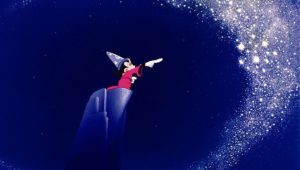
Fantasia was released in 1940, following the successes of Walt Disney’s beloved Mickey Mouse, Snow White and the Seven Dwarfs, and Pinocchio. It is a story combination of stunning animation that is complimented with as one would consider elites scores.
With his name established, Walt had other plans to pursue. With Fantasia, Disney hoped to achieve something else. Something greater. He once told his staff, “we’ve got more in this medium than making people laugh.” The new film, he said, would “change the history of motion pictures.” And despite its initial box-office failure and high criticisms, Fantasia grew to be one of Disney’s greatest creations in getting audiences to view animation in a different art medium. A respected one.
Now, mentioned above, why would someone believe the music in this particular film to be elites? Well, all the scores are classical pieces. With the rise of classical music during the renaissance, it has been heavily believed that the classics were made exclusively for the higher class and the educated. However, I believe Walt had no intentions for exclusivity and hoped for new listeners to experience classical music in a different way. The film was being developed just in the year before World War II, already taking a big risk for and early Disney movie. Having a film with animated visuals to complement classical scores was not exactly what audiences were expecting from young Walt Disney’s work history.
After Fantasia’s release, there were many mixed reviews. It was even considered to be a box-office failure. Before the movie’s release, Disney devised a first-of-its-kind, surround-sound system he called Fantasound, to be installed in first-run theaters. Disney imagined adding new segments in the future, so the film could be released again and again. But Fantasound turned out to be too expensive to install in every theater. The film had to be substantially cut. After early critical enthusiasm, NewYork Times even calling it a” delightful and exciting” creation, audiences seemed baffled or bored by it. It lost more than the modern equivalent of $15 million and nearly drove the company into bankruptcy.
Many were amazed by the advancement in using Fantasound in earlier theaters only. However, many others were also appalled by the visuals. It was deemed even as a far as wild and brutalizing. I believe it was greatly criticized merely from the fact that the audiences were expecting films such as Pinocchio and Snow White again. But many at the time seemed to not understand the actual significance of the tools used in creating the story, making it a great film and in fact very similar to Snow White.
The combination of classical music and vibrant and bouncy visuals create a sense of fantastical realism. It is the same pattern that Walt has done within Snow White and MGM’s The Wizard of Oz. Walt always knew that in order to change the value of animation as an art form, the audience first needed to be grounded into the story and characters while also enjoying the lively art animation was supposed to be. Just how Walt brought realism to Snow White’s features and life struggles and just how Victor Fleming wrote deep relatable themes in the relationship of Dorothy’s friend group, bridging the “elites” classical music to playful animated characters helped ground the genre of animation and allowed all classes and social groups to experience, essentially animated classical music in a new way.
The movie itself did not bring Disney to the high class status Walt Disney was hoping for but it opened a long bridge of utilizing classical music within animated pictures for generations to come.
Sources:
https://www.smithsonianmag.com/arts-culture/disney-fantasia-critical-box-office-failure-180956963/
